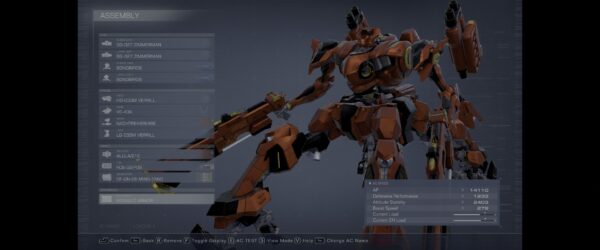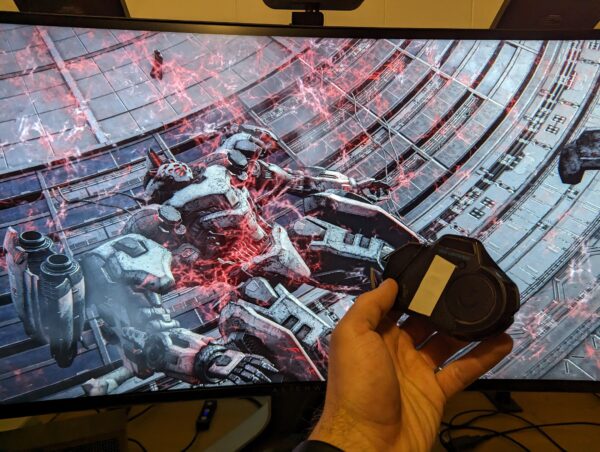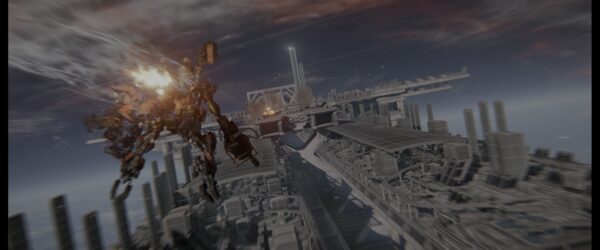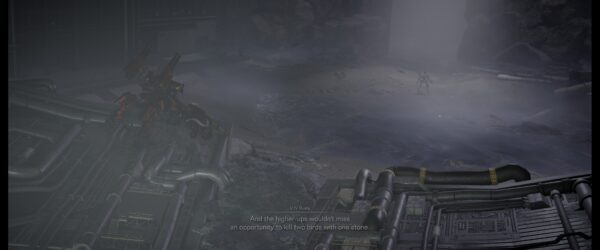Elden Ring graduated FromSoftware from highly successful and critically acclaimed developer to a household name among gamers and non-gamers alike. So their website indicating that their next game would be in the Armored Core series raised a few eyebrows, myself included. Whilst I’ve been a fan of mech games for a long time I’d never given that particular IP a spin, so I was going in blind to what the game was and whether or not I’d actually enjoy what it was putting down. Suffice to say that whilst I had a rocky start with it Armored Core VI really grew on me, both in terms of its fast paced mecha combat but also its narrative. That’s not something I’ve really come to expect from a FromSoftware title.

You are 621, 4th generation augmented human and current resident of what looks like a body bag. Walter wants to give you a reason to live: become one of his hounds and he’ll get you jobs with the corps, giving you credits and a steady supply of ammunition. Your first mission is to get a license to operate an Armored Core (AC) on the surface of Rubicon, something that’s not going to be given to you freely. Once you find one you’re set to work, doing odd jobs for the corporations either fighting each other or the natives of the planet. What Walter’s ultimate goal for you, or even himself, isn’t clear to you but given you don’t have much choice in the matter you keep doing missions for him, building a reputation as one of the better hounds he’s had. The path ahead is in your hands though as you’ll eventually be given discretion over what missions you should, or should not, take.
It’s kind of interesting to see the usual FromSoft visual stylings in a sci-fi setting, the half a step back generation graphics not seeming entirely out of place for a fast paced mech shooter. You’ll be spending most of your time in massive open environments moving at breakneck speeds so you often won’t have time to stop and admire the scenery. That being said there’s been a lot of attention paid to the details that matter, like the ACs and other set pieces which have an incredible amount of detail to them. The game needs a few tweaks to get performance running consistently but once you’ve got that dialled in you’ll find yourself revelling in high octane action for as long as you can take it.

The core game loop of Armored Core is pretty simple: fit out your mech, go on a mission, earn credits, unlock more parts and repeat. The game is upfront about the fact that some builds are going to be better than others, and you’ll need to customise your mech to fit the mission. Whilst this is somewhat true there are, of course, builds that will do well 95% of the time and you’ll only need to make small modifications to them in order to get past whatever thing is blocking your path currently. The missions are short, usually only 15 minutes max or so, which is done to encourage you to experiment should you find yourself up against a brick wall of progress. There’s a couple other game modes included as well: an AI 1 on 1 mech battle simulator, pitting you against other NPC’s ACs and a PVP multiplayer arena. Compared to other FromSoft titles it’s definitely a lot more focused in its implementation, something which might shock players who were expecting Elden Ring levels of complexity and build diversity.
Combat is a fast paced, mech on mech battle simulator that has all the things I’ve come to love and expect from this genre. Quite often you’ll start out laying waste to endless numbers of smaller enemies, trying to keep the damage and ammo usage to a minimum. Yes this is a game with ammo in it and you can 100% run out of it before completing a mission, putting you in a rather awkward position if you’re trying to fight a boss. For the most part the challenge comes from timing your dodging and firing as the enemy can move just as fast as you and will often come with weapons that will swamp the area with obstacles you need to avoid. One thing that the game neglects to mention though is how the lock on system works and, more importantly what will break it.
Moving your fscking mouse.

The picture above is my solution to ensuring that I retained lock on to some of the game’s more challenging bosses, ones that would routinely break aim lock by getting behind me. The crazy thing is though that your AC will keep proper lock on to any enemy you point it at, just so long as you don’t move the mouse. Try to move your cursor so you can maintain lock on the target? Nope, that’ll break it and you’ll instead have to wait to get lock again before you can fire. I cannot tell you how much easier the game would’ve been had I known that, given that most of the enemies I struggled with were the fast moving ones. Given how many people on the forums are complaining about certain boss difficulties because of this exact issue I can’t be the only one who resorted to taping their mouse up just so they could actually hit things.
That being said though even with that trick your build will still heavily influence just how hard or easy a particular boss fight will be. For the initial boss fights this can be a real challenge as you don’t really have a massive arsenal to draw on in order to find the right rock for the scissors that you’re about to fight. Later on it gets a bit easier as you’ll have a few more weapons at your disposal and can usually make do. Failing that going back to the main mission screen and selling things is a viable option because you sell and buy things for the same price. This makes your credits effectively your level, providing your access to a certain number of parts overall which you can use at your discretion. For what it’s worth at around half way through my play through I had access to most things required to get me through pretty much any encounter, with further upgrades simply giving me more survivability or improving my quality of life.

The singleplayer missions are pretty straightforward for the most part, usually just involving you killing a bunch of things before they kill you. There are some notable exceptions with a few stealth levels that either fail or get extremely difficult once you’re detected. There’s also the set piece bosses which are less about your build or skill and are more just elaborate quick-time events that you have to get yourself through. Their short length does lead to replayability though and if you’re someone who’s looking to min/max things then there’s every opportunity to eek out a few more credits by optimising your build and play style for each mission.
Whilst not a technical issue per-se I did find myself getting lost or bewildered more often than I’d like to admit to. The game does have in-built navigation aids to mitigate this, but they can sometimes lead you astray when they’re leading you in a direction you don’t want to go. I usually found myself in this situation when there was a timed objective or similar, so I was trying to get to where I was going as fast as I could. This could also be the due to the twitchy nature of the controls, your AC responding very quickly to input. Not a major gripe, but something to be mindful of.

PLOT SPOILERS BELOW
I was ready to bounce off the game’s narrative after a few hours, mostly due to the lack of detail and character progression I was seeing. I’m quite glad I didn’t though as whilst the story development is slow to start off with it builds on itself well, each of the reveals giving you a bit more insight into the dark world of Rubicon that you’re now finding yourself at the center of. Each of the main characters are given enough time to develop and shine, with even a good few of the secondary cast getting enough screen time to make their roles actually mean something.
What really drew me in though was the way that they made me empathise with numerous different characters and then forced me to make a hard choice that’d betray someone I cared about. I was all for fucking over the corporations and helping out the RLF, but eventually it became clear that Walter’s motivations weren’t just to be another corporate fixer. Faced with the choice of helping the person who gave me a reason to live vs betraying those I’d wanted to help (and in turn, put myself in the crosshairs of the only person who saw me as human, Rusty) was not something I was expecting to come across in this game. Doing it with such minimal dialogue too, relying on little snippets from different parts of the game to build out that narrative, just made it all the more impresive.
PLOT SPOILERS OVER

If you’d asked me a week into my playthrough of Armored Core VI what I thought of it I would’ve told you it was a competent, but mediocre mech battle sim. Spin forward just a few more days though and I was singing its praises from the rooftops, the combination of deep customisation, enthralling combat and a narrative that actually had meaningful choices and I was hooked. Whilst I haven’t gone back through another 2 playthroughs to get the other endings (and I’m not sure if I ever will) Armored Core VI managed to impress me in ways I simply wasn’t expecting. Hats off to FromSoft for making this their next game after Elden Ring, even if it did mean that DLC for that game is still far off in the distance.
Rating: 9.25/10
Armored Core VI is available on PC, PlayStation 4, PlayStation 5, Xbox One and Xbox Series X/S right now for $89.95. Game was played on the PC with a total of 16.9 hours playtime and 53% of the achievements unlocked.



